|
|

|
|
Author
|
Topic: Dangerous Films/Discovery Channel "When We Left Earth" documentary
|
Robert Pearlman
Editor Posts: 42981
From: Houston, TX
Registered: Nov 1999
|
 posted 09-06-2007 11:35 AM
posted 09-06-2007 11:35 AM
   
NASA release NASA Partners With Discovery Communications for 50th AnniversaryNASA and Discovery Communications will join in a broad media partnership to commemorate the space program's 50th anniversary. The space agency, which was created by the National Aeronautics and Space Act, began operations on Oct. 1, 1958. The announcement was made Wednesday in New York at a premiere screening of "In the Shadow of the Moon," a film in which crew members from NASA's Apollo missions tell their story in their own words. Discovery Channel will air the world television premiere of the film in the summer of 2008. "This partnership with Discovery Communications enables NASA to bring the excitement of 50 years of exploration and discovery to a wider audience," Robert Hopkins, chief of strategic communications at NASA Headquarters, said. "This leverages NASA's compelling content with Discovery's state-of-the-art production capability and technology to tell the NASA story – past, present and future – through a variety of media and platforms." The partnership will encompass on-air and online components as well as grassroots activities throughout 2008, including educational workshops and local screenings. Special programming on Discovery in the spring and summer of 2008 will celebrate NASA with never-before-seen archival footage. Podcasts and interactive features at Discovery's Web site will enable viewers and users to take a closer look at NASA's history and its plans for the future. "We honor not only 50 years of wonder, achievement and surprise; but also look toward a bright future of new discoveries. Our planned 2008 specials and series documenting NASA's greatest moments will inspire a new generation to explore and innovate," said Jane Root, president and general manager, Discovery Channel and The Science Channel, Silver Spring, Md. NASA and Discovery are teaming through a non-exclusive Space Act Agreement with no exchange of funds. |
Robert Pearlman
Editor Posts: 42981
From: Houston, TX
Registered: Nov 1999
|
 posted 12-16-2007 09:10 AM
posted 12-16-2007 09:10 AM
   
Kennedy Space Center Spaceport News: London film crew tells NASA's storyFor NASA's 50th birthday in October 2008, Dangerous Films for the Discovery Channel will present the dramatic story of the space agency's pioneering, awe-inspiring missions. Dangerous Films is a production company based in London. Its production team recently spent two weeks at Kennedy to prepare stories for the six-part series, such as the shuttle's recovery from disaster. The film will also include heroic struggles to break the sound barrier and the Apollo-Soyuz link-up. 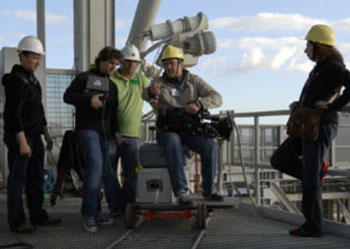 According to assistant producer James Leigh, the film company's work for the first part of the project began six months ago. Arranging accreditation for all the Dangerous Films personnel was an early step. Then there were contacts to arrange for interviews, such as with Leroy Cain, Scott Carpenter and Jon Clark, husband of Laurel Clark, who was lost in the Columbia accident. Finally, there were arrangements to be made to film at various locations at Kennedy. That also required the appropriate equipment, most of which was rented in the U.S. In all, the team comprised 11 people for the Kennedy shoot and three vans of equipment. None of that would have been possible without the help of Kennedy's External Relations Press Site. "Many teleconferences, phone calls and e-mails made it happen, beginning in August," said Manny Virata, lead media projects coordinator. The company first scheduled scouting trips in August and September to identify sites they wanted to use. Then permissions had to be sought to film there. Some the team handled directly. Most went through the Press Site. Aiding Virata was Mary Hunter of All Points Logistics and NASA's Laurel Lichtenberger, who has the monumental task of accrediting everyone who needs to be on site. The teleconferences and phone calls eventually hammered out the badging and a schedule of what to shoot, where and when. However, the schedule is a boilerplate, subject to change due to over- or under-estimating shooting times, or people not available when needed. More than one interview had to be rescheduled, even changing venue from Kennedy to Johnson Space Center at a later date. Near the end of the filming, the photographer decided he'd like to capture some of the historic pads at sunset and sunrise. So the schedule was reworked to include five additional locations before and after the normal work day. The film shoot also was sandwiched around a shuttle rollout. 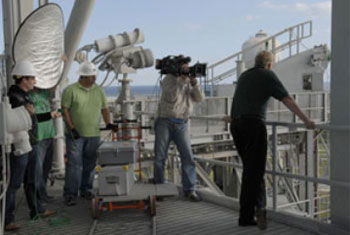 One of the events on the schedule was filming the interview with Jon Clark, not in a climate- and sound-controlled studio, but at the 195-foot level of the fixed service structure on Launch Pad 39A. That meant hauling a big jib, tracks and camera to that level and setting up in the open with winds of 12 knots. Leigh stated the interview took one month to arrange and one day to shoot, yet probably only a portion of the interview will actually air. The backdrop of the Kennedy environs no doubt was deemed worth the effort. Other areas the team filmed in November included Launch Pads 5, 14, 19 (the Gemini launch pad), 34 (scene of the Apollo I fire that claimed the lives of Ed White, Roger Chafee and Virgil Grissom), 39A and 39B, the Vehicle Assembly Building, the Columbia debris site, the crawler-transporter, Hangar S and the Launch Control Center where drawings by astronauts' children are displayed. The production team members were not blase about their job. "Pad 34 was really a remarkable site," said Leigh. "The legacy of the men -- Grissom, Chafee and White -- who died there led to getting a capsule right for a successful launch within a decade. They are heroes of the space age." Nick Green stressed the project focuses on how all the events of space history came to be, "not just the final outcome. The astronaut interviews are worth hearing because of the more personal, first-person experience being captured." Dangerous Films will be filming at Kennedy again in 2008 before editing begins in April. It will probably air before October. |
Robert Pearlman
Editor Posts: 42981
From: Houston, TX
Registered: Nov 1999
|
 posted 02-01-2008 02:45 AM
posted 02-01-2008 02:45 AM
   
Discovery Communications release Discovery Lifts Off On NASA's 50th Anniversary CelebrationDiscovery Communications launches its yearlong commemoration of the 50th anniversary of the National Aeronautics and Space Administration (NASA) as Founder and Chairman of Discovery Communications John Hendricks headlines a gala celebration on Thursday, January 31, paying tribute to legendary newsman Walter Cronkite. At the center of NASA and Discovery's partnership is Discovery Channel's landmark summer 2008 special event series When We Left Earth: The NASA Mission airing on consecutive Sundays, June 8, 15 and 22. For the first time ever, audiences will see the space age come to life in vivid, completely digitally remastered high-definition television. Discovery painstakingly restored mission and training footage, making these national treasures available for future generations through the NASA archives. The NASA/Discovery partnership includes these additional events and initiatives: - Science Matter! a nationwide, multifaceted initiative aimed at fostering students' interest in science, presented by Science Channel and Comcast and kicked off in Huntsville this past month
- Extensive online offerings of archives and podcasts
- Science Channel's 2nd annual SPACE WEEK, July 6-11
- NASA participation in Discovery's 2008 Young Science Challenge
When We Left Earth: The NASA Missions
Episode GuideFor 50 years, America has led the world in space exploration. Yet the boundless void that begins just 62 miles above us has been visited by no more than 500 people. When We Left Earth: The NASA Missions, a stunning high-definition series from Discovery Channel, opens up space like never before. The missions, the people and triumphs of exploration are revealed in a depth of detail previously experienced only by the astronauts themselves. Episode 1:
Project Mercury: Ordinary Supermen NASA, formed in 1958, one year after the launch of Sputnik, is leading the search for test pilots who have what it takes to enter the unknown of outer space. The seven men chosen to fly the Mercury capsule each know what it means to risk their lives. On average, one test pilot a week is dying in an air crash -- the danger of riding in a rocket will not faze these men. Still, the first American in space will face a number of unanswered questions: Will a man in space be able to swallow food or drink? Will he go insane? Will he die from radiation exposure? Faced with fierce Soviet competition, the race is on to answer these and many other important questions. President Kennedy dares America to get to the Moon within 10 years, and early missions are critical steps in a process that will culminate in the ultimate goal of landing a human on the Moon. Episode 2:
Friends and Rivals NASA understands that getting to the Moon and back means mastering the art of joining two spaceships in space. With that goal, NASA begins a new program dubbed Gemini and for the first time will launch two men into space in a single spaceship. Gemini is charged with achieving an ambitious set of advanced space travel goals, from long-duration flights to space walks. Cosmonaut Alexei Leonov completes the first human space walk in 1965, and astronaut Ed White becomes the first American to walk in space a few months later. Still, the challenges of rendezvous and docking with another spacecraft have yet to be accomplished by either NASA or their Soviet counterparts. In a bold, complicated mission, NASA plans for Gemini 6 to fly thousands of miles before catching up with an orbiting Gemini 7 in a breath-taking moment of space choreography. The Moon is in their sights. Episode 3:
Landing the Eagle In the summer of 1968 -- with the Gemini program having achieved its goals and the Apollo program in full swing -- NASA changes the mission of Apollo 8 to be the first manned flight to the Moon. Commander Frank Borman, James Lovell and William Anders become the first humans to leave the gravitational pull of Earth and see the far side of the Moon. The astronauts of Apollo 8 had traveled farther than any man had before, at 250,000 miles to the Moon and back. On July 16, 1969, Apollo 11 lifts off for a lunar landing carrying Neil Armstrong, Buzz Aldrin and Michael Collins and good wishes from the world. The world awaits the crew's Moon fate: Will the lunar module sink into the dust? Will the crew be attacked by "lunar germs"? Will they be able to blast away from the lunar surface once the mission is completed? Four days later, the astronauts land on the Moon. It is NASA's finest hour and one of the most triumphant moments in world history. Episode 4:
A Home in Space As NASA's confidence grows, the tentative steps taken by Armstrong and Aldrin are overshadowed by the feats of Charlie Duke, John Young and Gene Cernan (among others), who race around the Moon on lunar rovers. Lunar missions become more ambitious, culminating in Apollo 17's three-day stay in the Sea of Serenity. But budget worries force the cancellation of the final three missions, and the end of the Apollo program brings a search for new objectives. Man has orbited the Earth, walked in space, crossed from one spacecraft to another and even visited the Moon. NASA begins taking steps to further space exploration by sending Skylab into orbit along with a team of scientists. The Skylab mission would prove that humans could live and work in space for extended periods. U.S. astronauts are eventually invited to live aboard the Russian Mir space station, developing relationships in orbit long before the Cold War thaws out on Earth. Episode 5:
The Shuttle -- Triumph and Loss For 20 years, NASA had launched capsules carrying a maximum of three people -- drawn from an exclusive group of men, nearly all of whom are test pilots. The development of the reusable shuttle leads to a revolutionary approach to space travel. For the first time ever, groups of six or seven astronauts can fly into space at once. Described as a butterfly on a bullet, the shuttle is first flown by John Young, the man who sat alongside Gus Grissom on the first Gemini flight. The pioneers of NASA's manned programs are leading the way into the modern era of the space age. Yet space travel remains as dangerous as ever, as demonstrated by the 1986 Challenger shuttle disaster and the 2003 Columbia shuttle accident. But the development of the International Space Station -- human beings' boldest collaboration in space hardware to date -- meant that the shuttle could not be abandoned. Episode 6:
A New Space Age Billions of dollars over budget and 10 years behind schedule, NASA launches the Hubble Space Telescope aboard the space shuttle Discovery. One of the most complex instruments ever built, and the latest in an illustrious line of unmanned space missions, Hubble is expected to transform our understanding of the universe. But nothing happens. NASA has a serious problem. It is discovered that human error is to blame for a defective main mirror on the orbiting telescope. Hubble, our all-seeing eye into deep space, is short sighted. NASA decides to send the crew of space shuttle Endeavour to fix the problem. The mission requires months of intense training for the longest, most dangerous series of space walks of all time. It is NASA's greatest and most high-profile mission since the Apollo era. The mission manages to recapture the public's imagination, engaging people in space heroics like nothing since the Moon landings of the Apollo era. Our natural desire to explore and discover is back, and NASA plans to send men back to the Moon, Mars and beyond. |
Robert Pearlman
Editor Posts: 42981
From: Houston, TX
Registered: Nov 1999
|
 posted 02-01-2008 11:38 AM
posted 02-01-2008 11:38 AM
   
Discovery held a virtual press conference today live from the Davidson Center for Space Exploration in Huntsville, Alabama with Apollo astronauts Buzz Aldrin and Charlie Duke. Reporters were invited to e-mail questions. 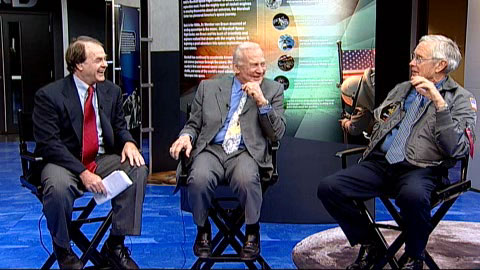 collectSPACE.com asked: Over the past 50 years, astronauts have said that TV broadcasts and photographs do not do justice to the scenes that you and your colleagues have seen firsthand outside spacecraft windows and spacesuit visors. With the advent of high definition TV and projects such as "When We Left Earth" restoring the footage you captured, how much closer is the public to seeing -- quoting yourselves -- the "magnificent desolation" and "intense blackness" of space? Buzz Aldrin: What good is high definition TV going to give you looking at space? You know, you are looking at stars, you are looking at black sky... you have to be looking at something. So if you're close to the Moon, then that is going to have a crisp, very clear [surface]. If you're looking inside the spacecraft, it is going to look like you're almost there. And if you look at another guy's face, you're going to see all the little blemishes and everything else. See, we don't have make-up people who go along on our crew. (laughs) Charles Duke: I've watched your [Discovery's] other programs in high definition and it is spectacular I thought. I mean, the first time I bought a high definition TV and watched one of your programs, golly, it was just so vivid. And I think that is going to capture what we see and what we felt and what we experienced, the reality, the vividness, the emotional side of it, that with the grainy TV, the pictures we sent back don't really capture it. By making this high definition of the films we did and the photographs that we took, it's going to be spectacular. People are going to awed. |
Lola Morrow
Member Posts: 40
From: Denver Co USA
Registered: Jun 2006
|
 posted 04-15-2008 03:03 PM
posted 04-15-2008 03:03 PM
   
Discovery assigned Dangerous Films, London to do the series. There was a great deal of phone and film interviews throughout the U.S. of the astronauts and space workers for months. They had done their homework and knew who were the people behind the scenes.
In Denver, they filmed Julie and Laura Shepard, Kris Stoever, Rene Carpenter and myself. The film director was very knowledgeable about our roles in the space program. I was asked so many questions over a 2 hour period that I don't remember all my responses. I told the film crew, "all this for about one to five minutes in the film" in which they agreed. Of course, there is always the concern of being misquoted or taken out of context. One never knows when giving interviews.However, I hope it will be an accurate and an illuminating film that will have a long lifetime and influence the public especially the younger generation to give their focus and support for future space exploration. |
Robert Pearlman
Editor Posts: 42981
From: Houston, TX
Registered: Nov 1999
|
 posted 05-01-2008 08:48 AM
posted 05-01-2008 08:48 AM
   
Variety: Gary Sinise to narrate Discovery series Discovery Channel has tapped thesp Gary Sinise to narrate its six-hour miniseries "When We Left Earth: The NASA Missions."Sinise previously narrated the cabler's 1998 program "Inside the Space Shuttle." "When We Left Earth: The NASA Missions" bows Sunday, June 8, at 9 p.m. and continues over the following two Sundays (June 15 and 22). Special marks the 50th anniversary of NASA and examines the agency from its early days to the present. "The story of NASA is really America's story -- people coming together with grit, audaciousness and determination," said Discovery Channel prexy-general manager John Ford. "Gary's stirring but straightforward narration conveys that perfectly." Sinise has been closely identified with space projects through his career, having played astronaut Ken Mattingly in "Apollo 13"; he also starred in the thriller "Mission to Mars." Dangerous Films is behind "When We Left Earth," which is exec produced by Richard Dale and Bill Howard. |
garymilgrom
Member Posts: 1966
From: Atlanta, GA
Registered: Feb 2007
|
 posted 05-01-2008 10:33 AM
posted 05-01-2008 10:33 AM
   
And I think that is going to capture what we see and what we felt and what we experienced, the reality, the vividness, the emotional side of it, that with the grainy TV, the pictures we sent back don't really capture it. It's great to hear Duke talk excitedly about HDTV enhancing what us land lubbers will be able to experience. I can't wait for this stuff! |
Robert Pearlman
Editor Posts: 42981
From: Houston, TX
Registered: Nov 1999
|
 posted 05-06-2008 07:14 AM
posted 05-06-2008 07:14 AM
   
Discovery Channel release Former Senator, Astronaut John Glenn Returns to Capitol Hill for Special NASA's 50th Anniversary PresentationDiscovery Channel Transfers Over 100 Hours of NASA Footage to High Definition in Special Archive Project, Archive Presentation - Tuesday, May 6 at 11:00 a.m. in S-115 Who:
Senator Bill Nelson (D-FL) and former Senator John Glenn (D-OH) host Discovery Communications Founder and Chairman John Hendricks' official presentation of over 100 hours of newly HD transferred NASA archives to NASA's Administrator Michael Griffin.
What:
In preparing for its epic new special series, When We Left Earth: The NASA Missions, Discovery Channel sourced over a hundred hours of original film and audio from NASA's vaults including film rushes and all the key on-boards filmed by the astronauts themselves. In addition, fragile original audio tape recordings from early space missions, nearly lost to degradation, have been catalogued and painstakingly restored. Footage both iconic and intimate; from Mercury, Gemini and Apollo, through the Soyuz link up, and the first un-tethered space walk; can now be seen for the first time in High Definition. These priceless national treasures will now officially be back with NASA as part of their permanent archives. This film library will be available to the public at unprecedented quality and resolution for the future generations of scholars, filmmakers and students to learn more about NASA's 50 years of challenge and accomplishment and what the future holds for America in space. Members of the House and Senate and press will screen clips of the newly HD transferred footage as part of this special event.
Where: The Capitol Building, Room #S-115 When: Tuesday, May 6, 2008 at 11:00 a.m. ET |
Robert Pearlman
Editor Posts: 42981
From: Houston, TX
Registered: Nov 1999
|
 posted 05-14-2008 03:28 PM
posted 05-14-2008 03:28 PM
   
Discovery is seeking first-hand accounts from NASA's historic missions to use for a podcast accompanying the release of "When We Left Earth": Tell Us Your Space Flight TalesJoin us in celebrating NASA's 50th anniversary by sharing your memories and stories of America's manned space missions. Please select from one of the topic areas below and give us a call. - First Orbits and Moon Journeys - CALL 866-947-NASA
Were you watching when Neil Armstrong took that first small step? Did you happen to catch one of the Mercury, Gemini or Apollo launches? Glued to the set when Apollo 13 was fighting to stay alive? Maybe you were even on one of the capsule recovery ships. Whatever your vantage point, dial the toll-free number 866-947-6272 and tell us all about it. - Engineers, Mission Control and Astronauts - CALL 866-948-NASA
If you are among one of the tens of thousands of specialists and engineers who built and maintained space vehicles, manned a console in a ground control station, or are even one of the chosen few who left Earth here's your chance to tell the rest of us what's it's like to have been a part of America's space program. Dial the toll-free number 866-948-6272 and leave us a message. - Shuttle Stories - CALL 866-949-NASA
With over a hundred flights since 1981, America's orbital space plane has been hard at work expanding scientific frontiers and helping NASA prepare for the moon and Mars. Along the way millions have had spectacular seats for launches, landings, and breath-taking orbital views. Call 866-949-6272 and let us know what you think of the missions so far.
You can also listen in on the messages being left. |
Blackarrow
Member Posts: 3118
From: Belfast, United Kingdom
Registered: Feb 2002
|
 posted 05-14-2008 06:07 PM
posted 05-14-2008 06:07 PM
  
For most people, the only way to see this series in High Definition will be when (if?) they release it on Blu-Ray disc. What are the prospects? |
Robert Pearlman
Editor Posts: 42981
From: Houston, TX
Registered: Nov 1999
|
 posted 05-14-2008 10:19 PM
posted 05-14-2008 10:19 PM
   
Discovery is now taking pre-orders for "When We Left Earth" in two formats:
When We Left Earth, The NASA Missions DVD Set

When We Left Earth, The NASA Missions DVD Set - Blu-ray Disc (for Blu-ray players only)
 DVD is $69.95; Blu-Ray is $10 more, both are Region 1 (US and Canada). Expected shipping is July 2008. |
Robert Pearlman
Editor Posts: 42981
From: Houston, TX
Registered: Nov 1999
|
 posted 05-15-2008 11:46 AM
posted 05-15-2008 11:46 AM
   
I attended a screening this morning of the second episode of "When We Left Earth". Discovery Communications hosted the event for NASA JSC with John Young there to answer audience questions afterwards.I am writing a more extensive review of the series to appear on this site and SPACE.com on June 5, but my first impressions were greatly positive. There did seem to be a tendency, at least in this episode, to lean a bit toward the melodramatic (e.g. Gemini 6 and Gemini 7 could collide with each other!) but it wasn't too much as to be distracting. The HD footage, projected against an IMAX screen, returned a lot of it to the grainy film we're all used to seeing. I suspect however, that watching this on an HDTV will be stunning. But visuals aside, the true highlight of this project, at least to me, were the interviews. In just this one episode, dedicated to the Gemini missions, you see and hear from Chris Kraft, Gene Kranz, Glynn Lunney, John Young, Jim McDivitt, Frank Borman, Jim Lovell, Gene Cernan, Buzz Aldrin, Dave Scott and Neil Armstrong (yes, you read that correctly, Armstrong is on screen, sharing his recollections of Gemini 8). Gary Sinise was an excellent choice as narrator; his voice fits the footage well. Overall, it was great to see an hour dedicated solely to Gemini -- a program often overlooked -- though the confines of time still meant that not all the missions were covered. Gemini 5 is not mentioned at all, while Gemini 10 and 11 are summarized in a single sentence. The other flights all receive decent airtime, although the fine details from each are overlooked (e.g. there's no mention of Gemini 6's Agena, but the Titan's on-pad abort does feature prominently). This episode mixed humor with suspense, delivering an engaging hour of TV, even for someone who was well familiar with the history involved. |
GoesTo11
Member Posts: 1309
From: Denver, CO
Registered: Jun 2004
|
 posted 05-15-2008 01:06 PM
posted 05-15-2008 01:06 PM
   
Wow...They couldn't get Armstrong for "In the Shadow of the Moon" but the Discovery Channel got him. I am impressed. |
mjanovec
Member Posts: 3811
From: Midwest, USA
Registered: Jul 2005
|
 posted 05-15-2008 11:01 PM
posted 05-15-2008 11:01 PM
   
quote:
Originally posted by Robert Pearlman:
Gemini 5 is not mentioned at all
I suspect there are two reasons for this: - Gemini VII sort of trumps Gemini V, as far as long duration missions go. Not only was VII longer, but it had a role in the rendezvous.
- Both crew members of GT-V are now deceased, so it was hard to find a "voice" for that mission. Perhaps the absence of Dick Gordon's voice also cut back the coverage of Gemini XI.
I am glad to hear Armstrong was interviewed about Gemini VIII. Perhaps he saw In the Shadow of the Moon and regretted not participating in that fine project. Regardless, it's good to get his thoughts about that mission on film. Presumably he will also talk about Apollo 11 in the third episode.I see the DVD set will have five hours of extras. Hopefully longer sections of the interviews are presented. |
spaceman
Member Posts: 1104
From: Walsall, West Midlands, UK
Registered: Dec 2002
|
 posted 05-22-2008 04:41 AM
posted 05-22-2008 04:41 AM
   
Follow this link to the new website. Assemble your spacecraft and launch it amongst many other things!Well done Discovery Channel. |
Hawkman
Member Posts: 400
From: Union, New Jersey
Registered: Jan 2001
|
 posted 05-26-2008 08:28 PM
posted 05-26-2008 08:28 PM
   
Here's what I don't understand. Seeing these ads for the series on tv of course makes it 'must see tv' for me...especially since my brother and I just bought a High Def tv for my folks.But the whole 'never before seen footage' leaves me a bit skeptical since Mark Gray HAS seen it and published it already through Spacecraft Films. No? |
spacecraft films
Member Posts: 802
From: Columbus, OH USA
Registered: Jun 2002
|
 posted 05-26-2008 09:03 PM
posted 05-26-2008 09:03 PM
   
The question you need to ask yourself about the "never before seen" claim is really very simple. Just exactly how would one determine truthfully that footage from 40-50 years ago had been "never before seen." |
tr
Member Posts: 24
From: Laguna Niguel CA, USA
Registered: Feb 2007
|
 posted 05-26-2008 10:17 PM
posted 05-26-2008 10:17 PM
  
Maybe "NASA's secret film vaults" also has behind the scenes footage showing how they faked the landings in a film studio!  |
Robert Pearlman
Editor Posts: 42981
From: Houston, TX
Registered: Nov 1999
|
 posted 05-27-2008 09:32 AM
posted 05-27-2008 09:32 AM
   
quote:
Originally posted by mjanovec:
I am glad to hear Armstrong was interviewed about Gemini VIII. Perhaps he saw In the Shadow of the Moon and regretted not participating in that fine project.
New York Post: Chasing the Man on the Moon Interviews with the famously reticent Armstrong, 77, were conducted just six weeks ago in Barcelona, Spain, for the six-part series, which premieres Sunday, June 8.In TV terms, that's last minute. "It just took a lot longer to find a time and a place that he was willing to do an interview with us," says Discovery's Bill Howard, executive producer (along with Richard Dale) of "When We Left Earth: The NASA Missions." |
mjanovec
Member Posts: 3811
From: Midwest, USA
Registered: Jul 2005
|
 posted 05-27-2008 10:14 AM
posted 05-27-2008 10:14 AM
   
quote:
Originally posted by spacecraft films:
The question you need to ask yourself about the "never before seen" claim is really very simple. Just exactly how would one determine truthfully that footage from 40-50 years ago had been "never before seen."
I suspect you are interpreting the "never before seen" claim a little too literally. The likely idea is that the footage has not been widely seen by the general population...not that no human eyes have watched the footage in 40-50 years. For most viewers, it is likely that they have never before seen the footage. Granted, I wish they could come up with a better way if saying it...perhaps say "rarely seen footage" instead. |
spacecraft films
Member Posts: 802
From: Columbus, OH USA
Registered: Jun 2002
|
 posted 05-27-2008 12:47 PM
posted 05-27-2008 12:47 PM
   
They chose the phraseology, I didn't. I'm simply interpreting it the way they are writing it. Words have meaning and should still matter."Rare" footage might suffice. And the line about "original mission footage from NASA's secret film vaults" is, frankly, nonsense. |
Hawkman
Member Posts: 400
From: Union, New Jersey
Registered: Jan 2001
|
 posted 05-27-2008 03:34 PM
posted 05-27-2008 03:34 PM
   
quote:
Originally posted by spacecraft films:
They chose the phraseology, I didn't. I'm simply interpreting it the way they are writing it. Words have meaning and should still matter."Rare" footage might suffice. And the line about "original mission footage from NASA's secret film vaults" is, frankly, nonsense.
I still like to tell people about the Spacecraft Films 'Gemini' set and just sitting there watching transfixed like a little kid watching footage of the "Angry Alligator". It was footage that I had never seen or even seen a hint of in all the years that I have seen shows or films on space. Truly 'never before seen footage'...by me. Someone had to develop it and look at it. I wonder if they blindfolded the guy who developed it? I'm sure that 'When We Left Earth' will be a great series but I can't help thinking that someone's job was made a lot easier by the work of Mark Gray and Spacecraft Films.  |
mjanovec
Member Posts: 3811
From: Midwest, USA
Registered: Jul 2005
|
 posted 05-27-2008 03:48 PM
posted 05-27-2008 03:48 PM
   
quote:
Originally posted by spacecraft films:
They chose the phraseology, I didn't. I'm simply interpreting it the way they are writing it. Words have meaning and should still matter.
The discussion at this point is still relatively academic, since it is feasible they have something in the film that we haven't seen before. Granted, it's not highly likely...but it's still possible. quote:
Originally posted by spacecraft films:
"Rare" footage might suffice. And the line about "original mission footage from NASA's secret film vaults" is, frankly, nonsense.
I agree that this statement is nonsense. But then again, maybe the "never before seen" footage came from the "secret film vaults" that you haven't been granted access to. After all, they are a secret, aren't they?  |
spacecraft films
Member Posts: 802
From: Columbus, OH USA
Registered: Jun 2002
|
 posted 05-27-2008 09:23 PM
posted 05-27-2008 09:23 PM
   
Not anymore. |
Hawkman
Member Posts: 400
From: Union, New Jersey
Registered: Jan 2001
|
 posted 05-27-2008 09:32 PM
posted 05-27-2008 09:32 PM
   
quote:
Originally posted by mjanovec:
I agree that this statement is nonsense. But then again, maybe the "never before seen" footage came from the "secret film vaults" that you haven't been granted access to.
The only thing that they might have that hasn't been seen might be a shot of Armstrong pressing ham against the LEM window.Other than that, I can't see what they might have that might be unseen.  |
Robert Pearlman
Editor Posts: 42981
From: Houston, TX
Registered: Nov 1999
|
 posted 05-27-2008 09:43 PM
posted 05-27-2008 09:43 PM
   
quote:
Originally posted by Hawkman:
Other than that, I can't see what they might have that might be unseen.
Are you only considering flight footage? What about training or PR footage? For example, the Gemini episode includes a short scene with Ed White jogging along the Florida coast. |
spacecraft films
Member Posts: 802
From: Columbus, OH USA
Registered: Jun 2002
|
 posted 05-28-2008 06:38 AM
posted 05-28-2008 06:38 AM
   
Our Apollo 1 DVD, released in 2007, has footage of Ed White jogging on the beach."Jogging-on-the-beach" footage was used extensively in period coverage, especially to demonstrate the "superman" angle of the astronauts in the early flights. There are jogging reels of many of them up through late the late Gemini flights and they were used on many flight's coverage in the biographical material produced on the astronauts. If that footage is from the "secret vault," the secret was out a long time ago. My point is that even though it might be possible that something is "unseen," whatever that might mean, it isn't provable, and therefore isn't valid. "Never before seen" is an extraordinary claim and should be backed by extraordinary evidence, but it has become just a throwaway marketing term. As many terms that are endlessly repeated it has, essentially, become meaningless. These days just about the only footage that might be "unseen" would be personal home movies never released publicly. Honestly, it really isn't that big a deal, it's just annoying puffery. |
mjanovec
Member Posts: 3811
From: Midwest, USA
Registered: Jul 2005
|
 posted 05-28-2008 11:59 AM
posted 05-28-2008 11:59 AM
   
Mark - Out of curiosity, I was wondering when you do your research if you come across any film cans or reels (of space-related footage) that ever make you wonder if anyone has viewed that footage in the 40 years since it was shot and developed (and, presumably, first viewed). Have you ever made a discovery that made you think "wow, I'm seeing something here that few people have seen?" (If so, can you share an instance or two with us?) Or do you think everything in the archives have already been seen several times throughout the years...even if the footage isn't commonly circulated? |
spacecraft films
Member Posts: 802
From: Columbus, OH USA
Registered: Jun 2002
|
 posted 05-31-2008 11:16 AM
posted 05-31-2008 11:16 AM
   
I've had many moments such as you describe. I can remember on the Saturn sets finally finding some of the footage taken on the inside of the propellant tanks. I'm pretty certain none of that material was either released or shown, and having read about the systems to record this footage it was very gratifying to find it and see it. For a project I'm working on now on Apollo television I ran across a reel of color footage taken at the Parkes Observatory and at Sydney Video around the time of Apollo 11. Previously only some black and white footage was known to exist. I could go on for a while with examples, including some that are still yet to be revealed, but that have been found. |
Robert Pearlman
Editor Posts: 42981
From: Houston, TX
Registered: Nov 1999
|
 posted 06-03-2008 08:19 PM
posted 06-03-2008 08:19 PM
   
Discovery Communications release Discovery Channel Takes Over Manhattan and a City Near You With Experiential MarketingDiscovery Channel launched a unique, immersive marketing campaign for its landmark special series, When We Left: The NASA Missions, premiering Sunday, June 8 at 9 PM (ET/PT). The marketing campaign for When We Left: The NASA Missions combines a variety of mediums and approaches designed to envelope consumers in the wonder of space. Out of home marketing includes a large presence in Manhattan with: - Bus ceilings and subway car wraps
- Video bus shelters at the following locations:
- 57th St Between 2nd & 3rd Avenues
- 34th St Between Madison & 5th Avenues
- 23rd St Between Lexington & 3rd Avenues
- 1st Ave Between 93rd St & 94th St
- 2nd Ave Between 66th St & 65th St
- University Ave Between 13th St & 14th St
- Times Square video board
- InWindow units take over store front window locations as a backdrop to promote When We Left Earth using video and sound:
- 201 East 57th Street
- 1035 6th Avenue
- 508 Columbus Ave
"When We Left Earth is all about the footage. The transferred high definition NASA archive is a key selling point and we are driving that message across all our creative," said James Hitchcock, Discovery Channel Marketing and Branding Officer. From space walks to lunar landings, these are images you have to see to believe."Over Memorial Day weekend special highlights of the spectacular never-before-seen footage from When We Left: The NASA Missions were projected larger than life onto the exterior walls of select movie theatres in New York, Chicago, Dallas, San Francisco, Houston and Philadelphia from sundown until 11:00 p.m. to give people a glimpse into space. Once inside the theatre, moviegoers saw an extended preview of When We Left: The NASA Missions on the big screen as part of the FirstLook digital pre-feature program, which was seen on 14,000 movie theatre screens nationwide. Other campaign elements include a massive online presence, including a Yahoo! homepage takeover, a CNN.com homepage takeover and interactive advertising on NYtimes.com. Print ads appear in Men's Journal, the New York Times Magazine, Time, Wired, People and TV Guide. 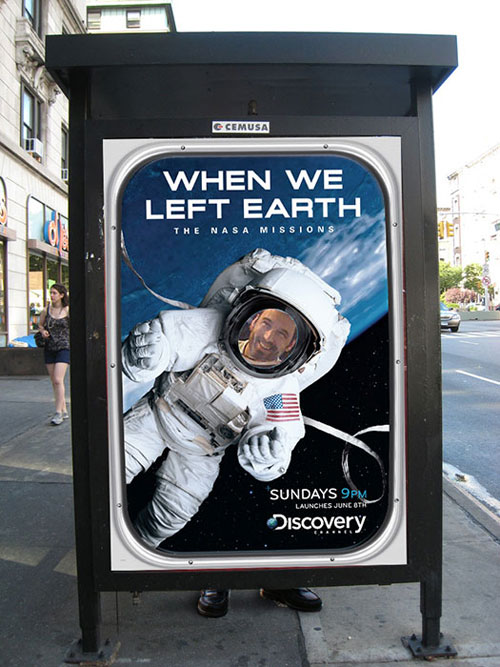 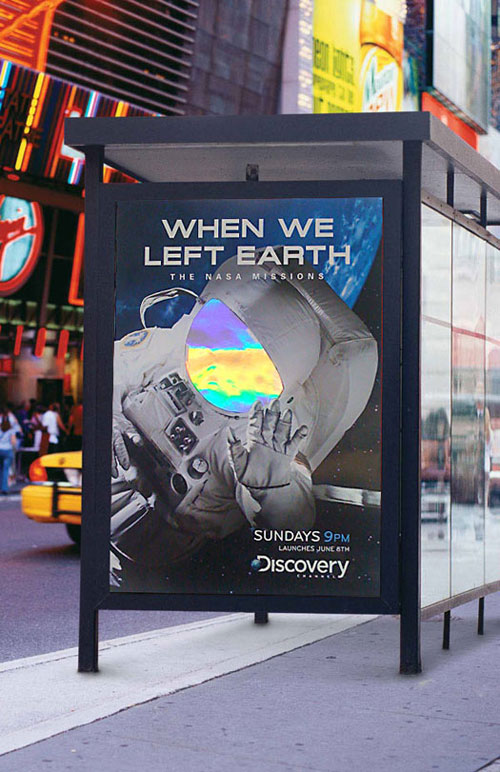
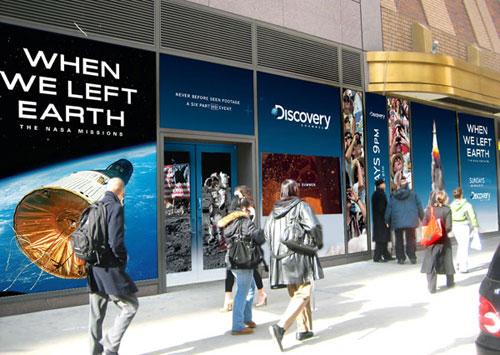
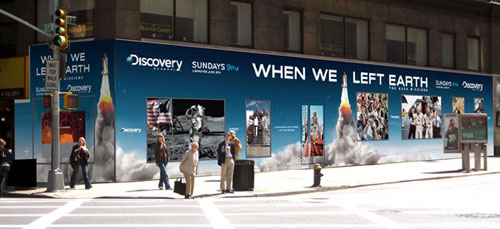
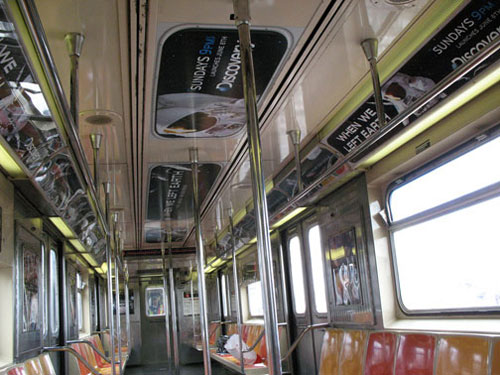
|
mjanovec
Member Posts: 3811
From: Midwest, USA
Registered: Jul 2005
|
 posted 06-04-2008 04:44 PM
posted 06-04-2008 04:44 PM
   
Not that I already need incentive to watch this show (...since I've already ordered the DVDs), the TV promos that Discovery Channel was running with the Rolling Stones "Gimme Shelter" as background music were really quite exciting. We often see space footage set to classical music, but seeing this footage pared with classic rock music also works wonders, especially since it it music of that era. I hope they incorporated some of this music into the documentary itself. |
GoesTo11
Member Posts: 1309
From: Denver, CO
Registered: Jun 2004
|
 posted 06-05-2008 02:03 PM
posted 06-05-2008 02:03 PM
   
I really like the Rolling Stones ad, too. When I watch the DVDs, I would expect most of the music to be sober enough to help communicate the grandeur of the subject, but I wouldn't mind a little classic rock & roll from the era, either. Is anyone out there really dying to see yet another space montage set to "Also sprach Zarathustra?" |
Robert Pearlman
Editor Posts: 42981
From: Houston, TX
Registered: Nov 1999
|
 posted 06-06-2008 10:21 AM
posted 06-06-2008 10:21 AM
   
Reviews: |
fabfivefreddy
Member Posts: 1067
From: Leawood, Kansas USA
Registered: Oct 2003
|
 posted 06-06-2008 11:57 PM
posted 06-06-2008 11:57 PM
   
I saw a great trailer for this before the start of a new movie at the theatre tonight. Looks great! |
DCCollector
Member Posts: 227
From: Washington, DC USA
Registered: Dec 2006
|
 posted 06-07-2008 04:04 PM
posted 06-07-2008 04:04 PM
   
For those who can't wait until tomorrow night, the second episode of the series, on the Gemini missions, is already available through the "On Demand" feature on Comcast cable. Interestingly, there is a six minute difference between the HD and the non-HD versions available (it looks like coverage of Gemini 8 was cut from the HD version). |
Hawkman
Member Posts: 400
From: Union, New Jersey
Registered: Jan 2001
|
 posted 06-08-2008 08:30 AM
posted 06-08-2008 08:30 AM
   
Robert, bravo on your Space.com/MSNBC article!I was especially thankful for your 'never before seen footage' caveat.  |
Robert Pearlman
Editor Posts: 42981
From: Houston, TX
Registered: Nov 1999
|
 posted 06-08-2008 08:52 AM
posted 06-08-2008 08:52 AM
   
Thanks Gene! As readers of this topic will recognize, the discussion here definitely helped shape the review... |
Hawkman
Member Posts: 400
From: Union, New Jersey
Registered: Jan 2001
|
 posted 06-08-2008 08:49 PM
posted 06-08-2008 08:49 PM
   
It would appear from what I have seen so far that the Discovery Channel has benefited from the work of Spacecraft Films given the quality of the onboard footage that I have sen so far. Don't tell me that DC 'remastered and restored' that footage when Spacecraft Films already did it.I hope that they at least give them a mention during the credits. |
Robert Pearlman
Editor Posts: 42981
From: Houston, TX
Registered: Nov 1999
|
 posted 06-08-2008 08:59 PM
posted 06-08-2008 08:59 PM
   
quote:
Originally posted by Hawkman:
Don't tell me that DC 'remastered and restored' that footage when Spacecraft Films already did it.
The source footage for "When We Left Earth" was direct film to HD transfers. I spoke with the NASA archivists who pulled the film. Spacecraft Films' DVDs were not involved, but it is a testament to the good work Mark Gray and his team have done on what I am sure was a smaller budget than Discovery's. |
Robert Pearlman
Editor Posts: 42981
From: Houston, TX
Registered: Nov 1999
|
 posted 06-08-2008 10:05 PM
posted 06-08-2008 10:05 PM
   
Discovery provided the second and third episodes to review, both in rough format (Sinise had yet to re-record the narration and Armstrong's 11th hour interview wasn't yet cut in). I saw the second episode in its final format though as part of a NASA screening. As my review reflected, I thought what Discovery accomplished was wonderful. That said, if I had the power to change one thing, I would have extended this series to 12 episodes and devoted (at least) two hours to each subject that is now just an hour. Watching the first episode about Mercury for the first time tonight, I couldn't help but think about what they could have done with an additional 60 minutes. Issues such as the Kraft vs. Carpenter comments could have been given the time they needed to provide a more complete picture (not to mention the far too brief mention of the X-15). The second episode came across as better rounded. It may have been because of the greater number of people interviewed, but it too could have benefited from more time. But that is a wish rather than a valid critique (which is why it wasn't included in the review). | |
Contact Us | The Source for Space History & Artifacts
Copyright 2020 collectSPACE.com All rights reserved.

Ultimate Bulletin Board 5.47a
|
|

|
 advertisement advertisement

|






















